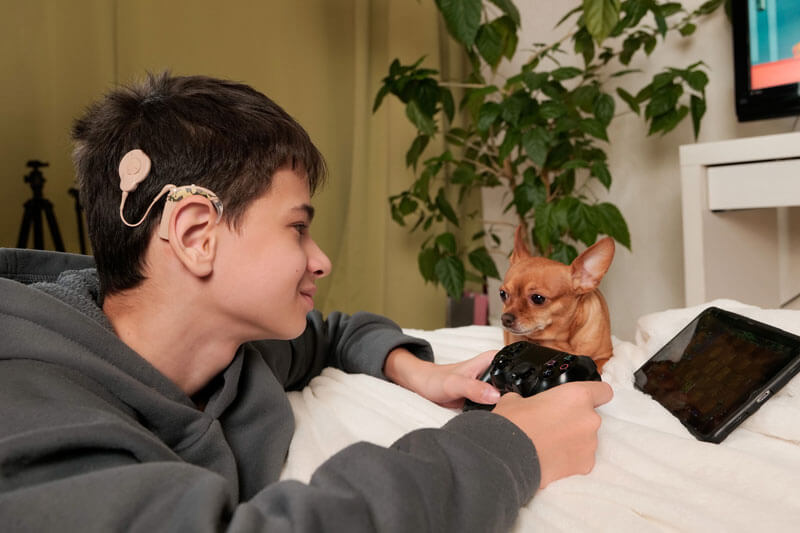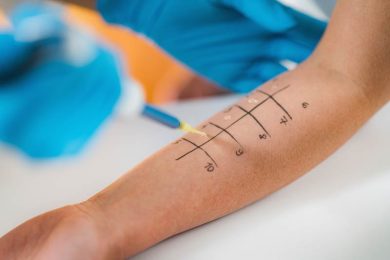What are Bone Anchored Hearing Devices?
A bone-anchored hearing aid (BAHA) is a surgically implanted prosthetic device that may help to partially restore hearing for persons with conductive, mixed, or single-sided deafness.
How Do Bone Anchored Hearing Devices Work?
A bone anchored hearing device works by transmitting sound vibrations through the bone. The sound processor converts the sound picked up by its microphone into vibrations. The sound processor then transmits the vibrations through the bones of the skull to the cochlear of the inner ear. The inner ear then converts these (sound) vibrations into electrical signals that the brain interprets as sound. A bone conduction hearing device therefore allows a child to hear sounds that can’t pass through the ear in the usual way, which is through the outer and middle ear.
Bone anchored hearing devices are usually made up of three parts:
1. The sound processor – This is worn behind the ear or on the body and picks up sound vibrations.
2. The abutment – This is surgically implanted into the bone and connects the sound processor to the bone.
3. The skin-penetrating abutment – This goes through the skin and is connected to the sound processor.
The surgery to implant a BAHA usually takes around 1-2 hours. A small incision is made behind the ear and the abutment is placed into the bone. The skin is then closed with stitches and a dressing is applied. Once the incision has healed, the skin-penetrating abutment is placed through the skin and connected to the sound processor. It’s important to keep the area clean and dry to avoid infection.
Who Can Benefit from Bone Anchored Hearing Devices?
If you experience chronic ear infections that do not respond to treatment, you may find the system particularly beneficial. Conventional hearing aids can aggravate the condition due to humidity and moisture building up in the ear canals. Those with congenital ear defects (such as ear canals that are narrow or absent) are good candidates as well.
BAHAs are also a good solution for those with single-sided deafness, or SSD. This is a condition in which hearing is lost in one ear, but not the other. The loss can be due to damage from an infection, head trauma, or other causes. Wearing a hearing aid in the good ear can help some, but in many cases, the sound is still unclear. This can be frustrating and make it difficult to communicate. A BAHD can provide clear sound to the deaf ear while leaving the good ear unaided. This can improve your quality of life and help you stay connected with loved ones and the world around you.
What are Adult Cochlear Implants?
How Do Cochlear Implants Work?
Cochlear implants are different from hearing aids in that they don’t just amplify sound. Instead, they generate an electrical signal that the brain can interpret as sound. This signal is created by an external device that sits behind the ear, which consists of a microphone, speech processor, and transmitter. These work together with the internal components of the implant, which include a receiver and an array of electrodes. The microphone picks up sound and sends it to the speech processor, which converts these signals into digital impulses. These impulses are then sent to the transmitter, which sends them to the receiver. The receiver then sends the electrical signals to the electrodes, which stimulate the auditory nerve. This allows the brain to interpret the signal as sound. Cochlear implants can help people with severe hearing loss or deafness to hear sounds and understand speech better.
What Is Cochlear Mapping?
Cochlear mapping is the process of programming a cochlear implant to optimize its functionality. This is done through a series of appointments with an audiologist or other specialist. During these appointments, the specialist will test your hearing and adjust the settings on your implant.
It’s important to keep in mind that each person adjusts to life with a cochlear implant differently. Some people may need more time and appointments than others. The important thing is to be patient and work closely with your specialist. With the right support, you or your loved one can make a successful transition to life with a cochlear implant. If you have cochlear implants, continuous adjustments are the best way to ensure you’re hearing and understanding your best.
Cochlear Implant: Making the Decision For Your Child
Cochlear implants are a very personal decision, and one that should not be made lightly. There are many factors to consider before moving forward with this type of surgery, and it is important to consult with your child’s physician, audiologist, speech-language pathologist, therapist and educators to get the most well-rounded picture possible.
Each child’s situation is unique, and there is no single “right” answer. Some families who have a child with hearing loss opt for American Sign Language (ASL) as their form of communication, while others choose to go the aural/oral route by way of listening and speaking. It is important to do what is best for your family and what you think will work best for your child.
There are many resources available to help you make this decision, and it is important to take advantage of as many as possible. There are also support groups available for both parents and children who have cochlear implants, which can be a valuable resource.
If you do decide to move forward with a cochlear implant for your child, it is important to remember that this is only one tool in the communication arsenal. It is still important to teach your child ASL or other forms of communication, as the implant will not be able to provide everything. Making the decision to get a cochlear implant for your child is a big one, but with the help of professionals and support groups, you can make the best decision for your family.
Cochlear Implant Orientation and Evaluation
During the cochlear implant orientation, the audiologist will explain the implant process and what to expect before, during, and after surgery. The audiologist will also go over the different types of cochlear implants and discuss which one may be best for your child.
The evaluation will help determine if your child is a good candidate for a cochlear implant. The audiologist will test your child’s hearing with and without hearing aids (depending on the child’s age). The audiologist will also talk with you about your child’s hearing and health history.
After the orientation and evaluation, the audiologist will answer any questions you may have about the cochlear implant process.
If your child is found to be a good candidate for a cochlear implant, the next step will be to schedule surgery. Surgery is usually scheduled within a few weeks of the evaluation. You will also be given information about what to expect after surgery and follow-up care. It is important that you follow the instructions given to you by the audiologist and surgeon to ensure a successful outcome.
Call Texas ENT & Allergy at (979) 693-7419 for more information or to schedule an appointment.





















